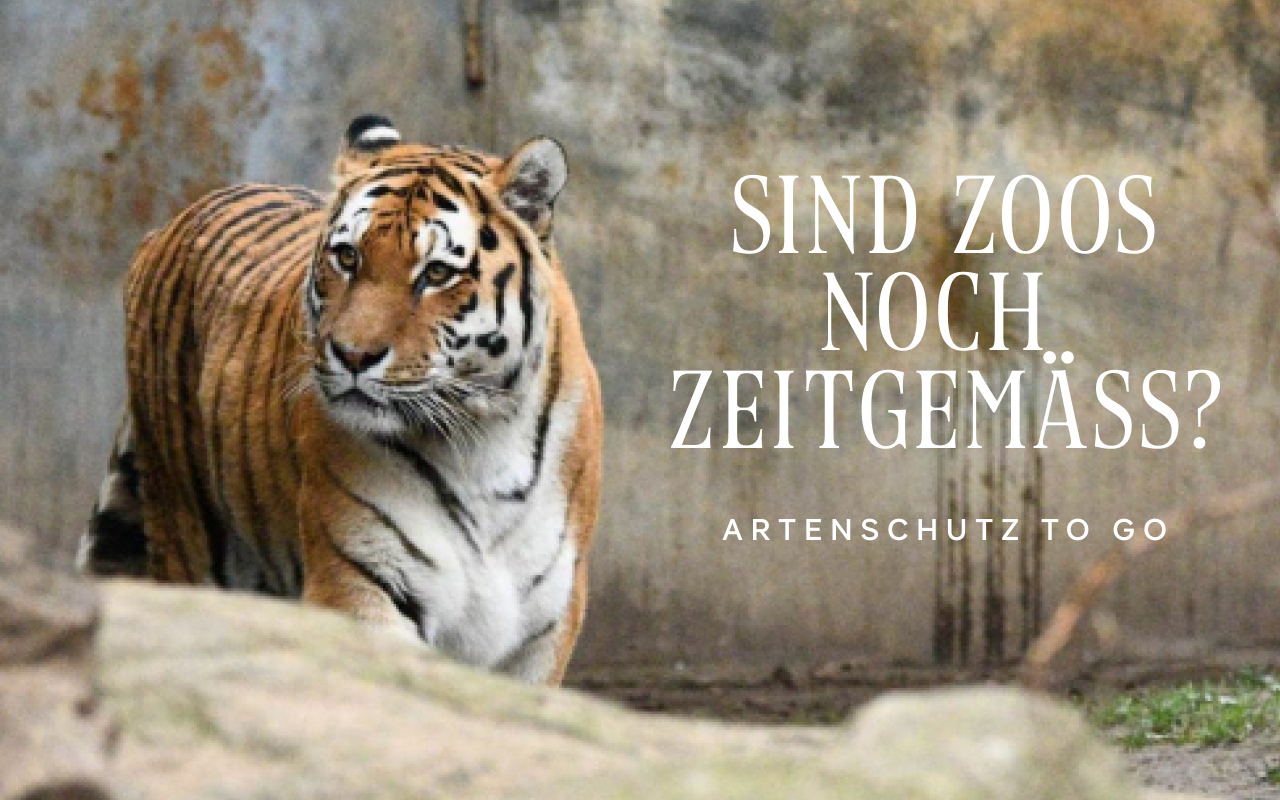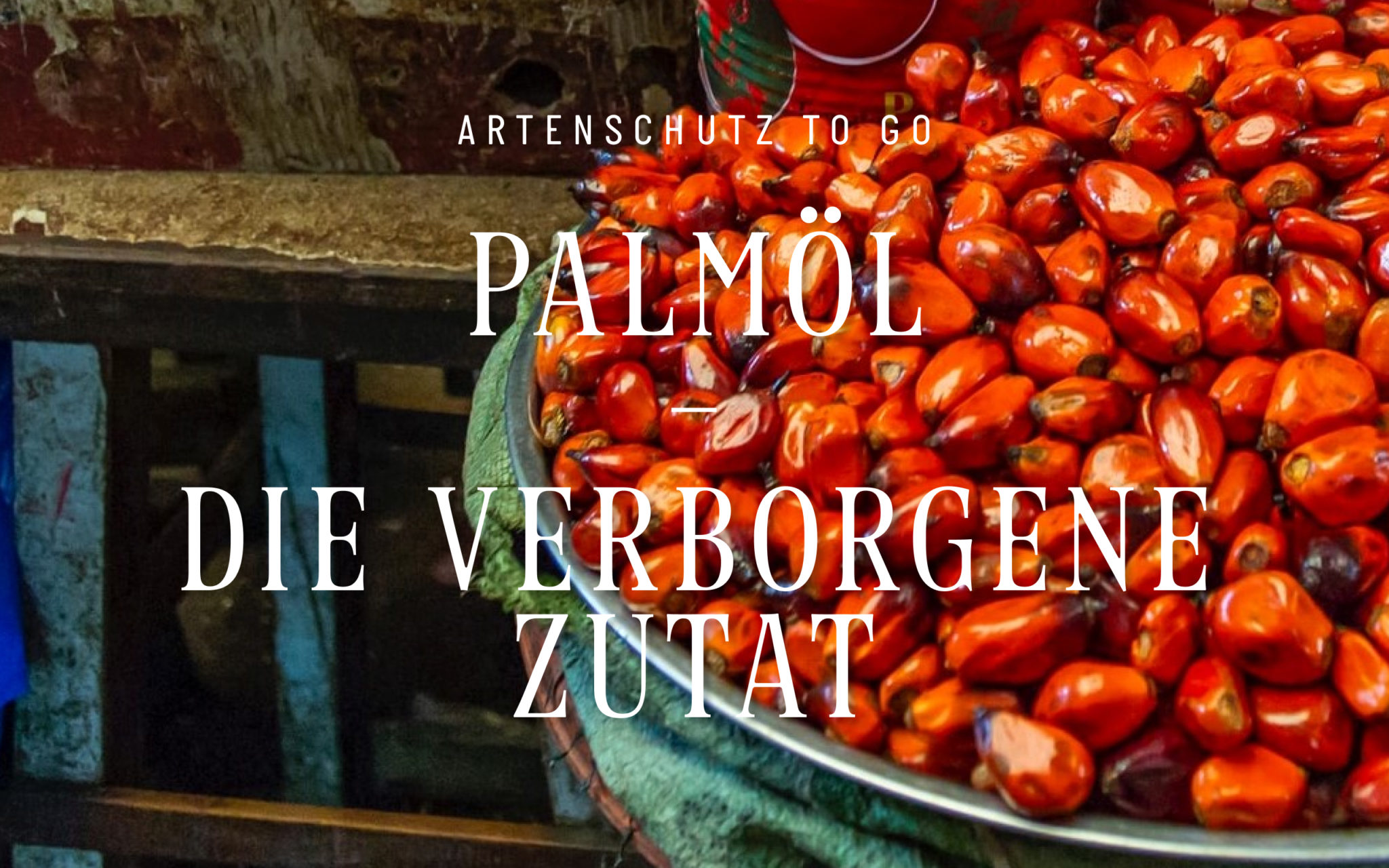
Borneo Gibbon – Last of its kind?
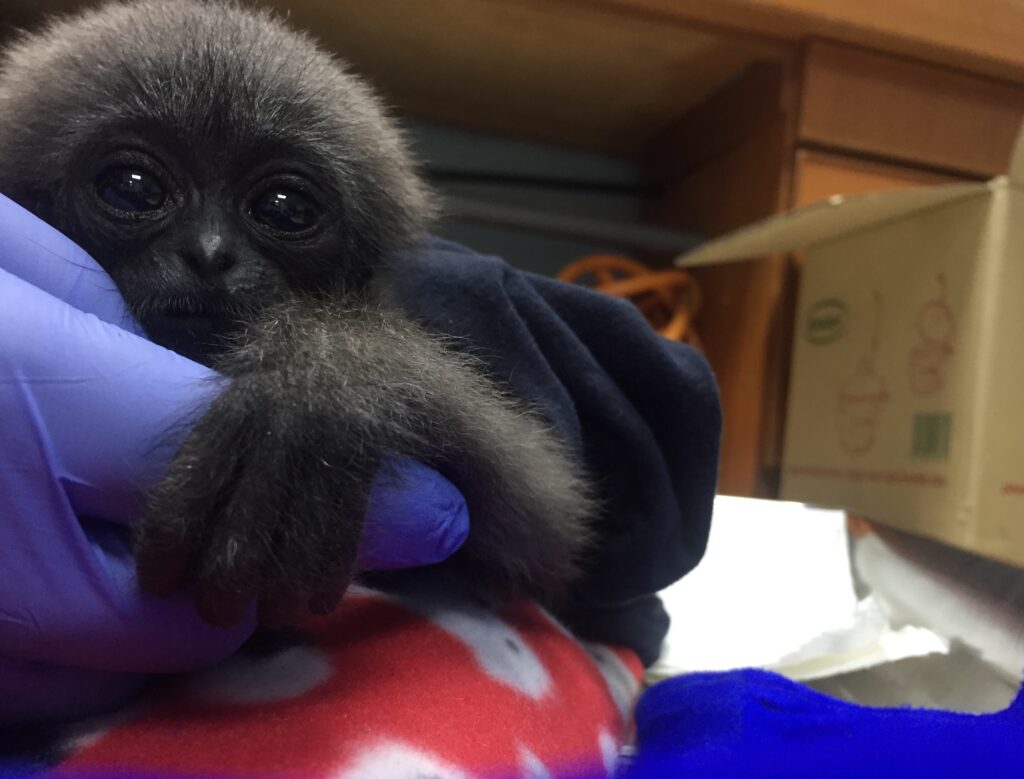
How 48 hours with a two-month-old baby gibbon, no bigger than my forearm, in the jungles of Borneo turned my life upside down.
Gibbons are closer relatives to humans than to macaques, baboons or langurs. And yet, they are much less known and studied compared to their larger relatives, chimpanzees, gorillas or orangutans. Yet Gibbons are unique in many ways: their social life, their movements, their anatomy and their way of communication. They are called “The singing apes” by the locals.
But now let’s take it one step at a time: I am a veterinarian and am currently supporting a species conservation project in the jungles of Borneo. However, in the national park, my everyday life here changes abruptly. This Wednesday, I’ve spent the morning taking samples in the lab and I’m sitting in front of a big mountain of rice with vegetables during my lunch break. The sun is shining and there is a sultry heat. A group of macaques is chasing through the bushes and hornbills are squawking loudly in the treetops. Suddenly, I see a group of park rangers running along the path to the office. Paloma, the veterinarian, is walking between them. When she sees me, she comes hurriedly towards me:
“Hannah, we have an emergency. One of the rangers found a tiny baby gibbon in the forest. We don’t know what happened, there’s no sign of the parents. It’s lying on the ground screaming.” I felt horrified and dropped everything to follow her into the forest. Gibbons live in small family groups of up to six animals, a social structure that occurs in only about three percent of all mammals. In addition, a gibbon pair stays together for life and there is a particularly close bond between family members. The parents would never just leave their baby behind, that’s for sure. So something must have happened.
“Hannah, we have an emergency. One of the rangers found a tiny baby gibbon in the forest. We don’t know what happened, there’s no sign of the parents. It’s lying on the ground screaming.” I felt horrified and dropped everything to follow her into the forest. Gibbons live in small family groups of up to six animals, a social structure that occurs in only about three percent of all mammals. In addition, a gibbon pair stays together for life and there is a particularly close bond between family members. The parents would never just leave their baby behind, that’s for sure. So something must have happened.
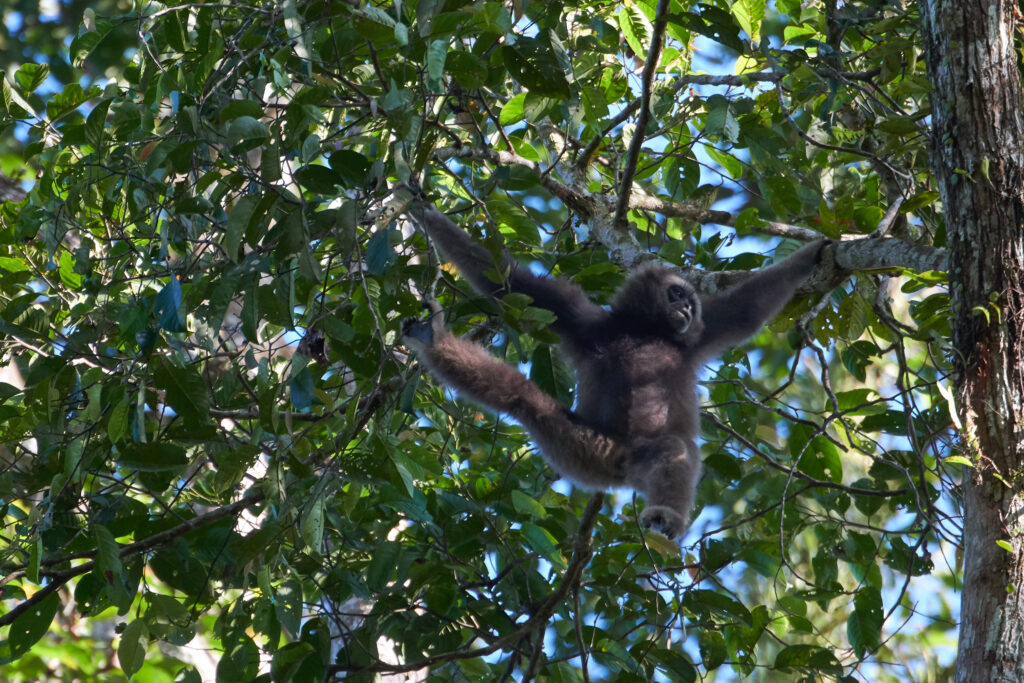
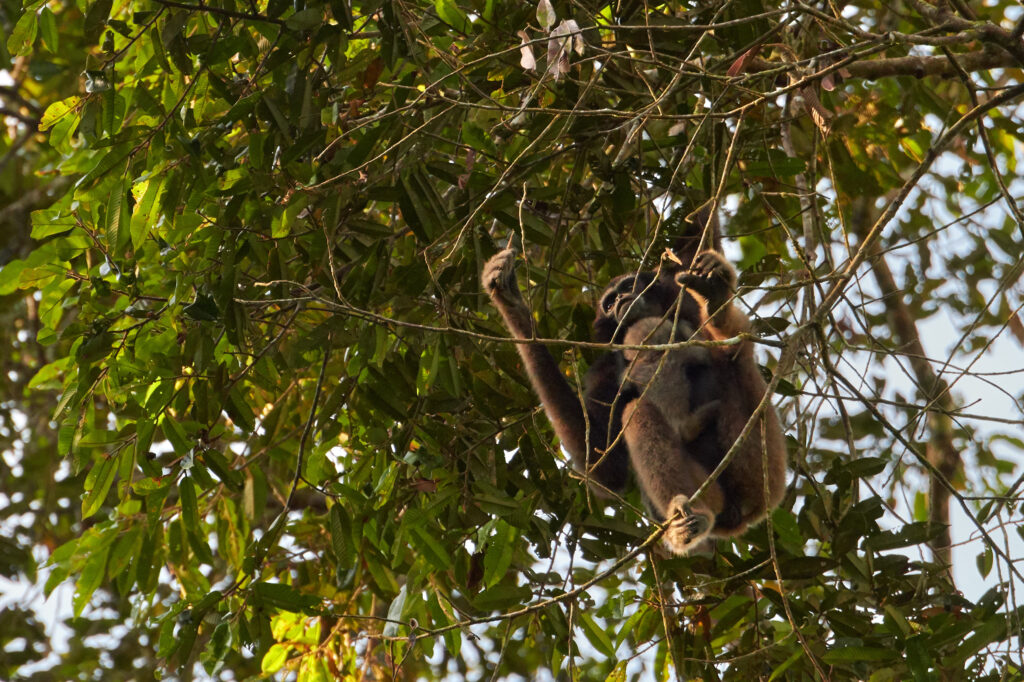
Gibbons inhabit the evergreen tropical rainforests of Southeast Asia. Their physique is adapted to life in the treetops. With their long arms they move around acrobatically swinging and shimmying. But especially outstanding are their territorial morning songs. They are among the most spectacular calls of mammals and wake me up every morning at seven o’clock sharp. I have never heard anything so beautiful before and the songs fill me with happiness every morning. It is a closely matched duet performed by both partners.
Of course, I know the two groups of gibbons that live in the national park, because they take the same routes every day and I have often followed them through the forest with binoculars. That’s why I also know the little gibbon baby, which in the beginning still clung to its mother’s belly as a fur ball and has already grown well in the last five weeks. With its big ears, high forehead, and beady eyes, it is one of the cutest babies I have ever seen and seems remarkably similar to a human baby – just like apes.
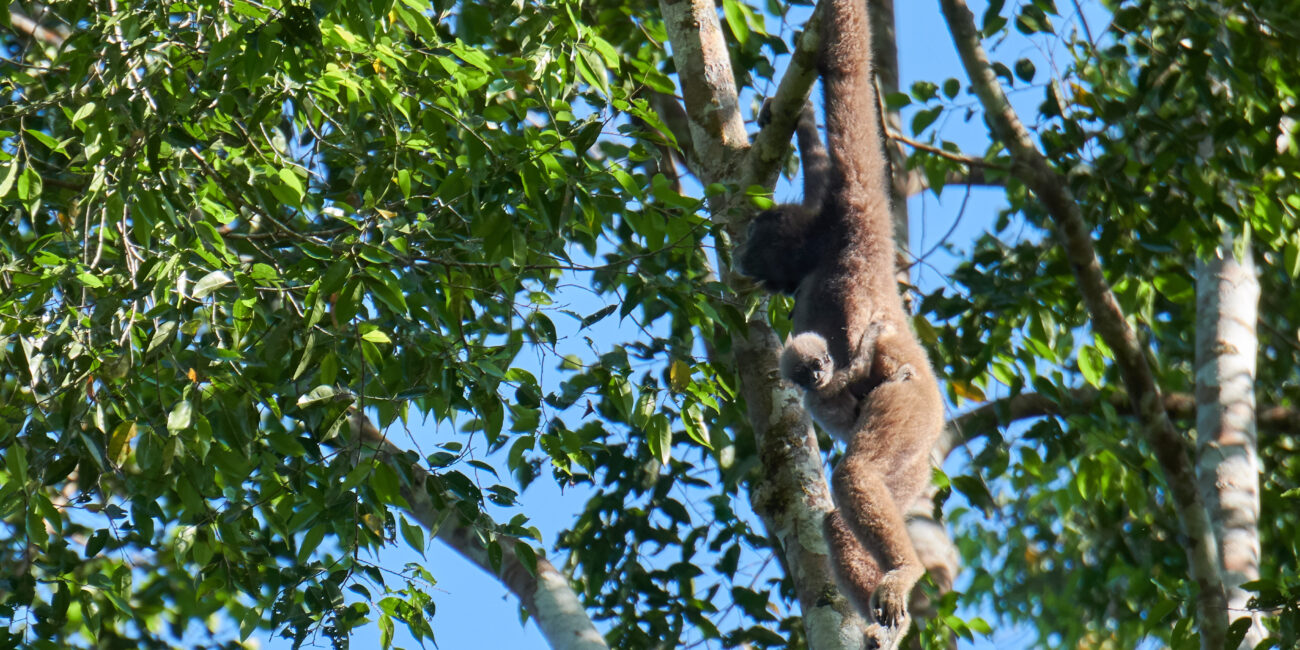
All this goes through my mind as I run after Paloma at a fast pace. Sweat runs down my forehead. Suddenly she stops abruptly and raises her hand in warning. The others stay behind and slowly the vet and I creep up to the little gray ball of fur on the ground. It lies hidden under a large leaf on the ground and has desperately stretched out a small arm with which it clings to a branch. I recognize the tiny fingernails on the little monkey hand. When it notices our presence, it starts screaming louder again, a real cry for help. I look up. The trees above the ape are twenty to thirty meters high. A fall from this height would actually mean certain death. But the little one seems to have been very lucky and has fallen onto a large, soft mountain of foliage. From a distance we try to examine the baby monkey. Neurologically it seems to be okay, we can’t see any external injuries and none of the limbs seem to be twisted.
“We have to give the parents another chance!” says Paloma firmly. “Let’s wait until evening and hope they come back. As long as the baby is still calling for them, it’s not lost yet.” “But this is an incredibly shy group of monkeys, they avoid humans,” I counter worriedly. “You’re right, let’s block off the path here. I’ll go to the entrance and you go to the other side – that way we’ll try to keep the tourists away, like this for just over a kilometer.” I nod. “And if the parents don’t come back?” “Then we’ll have to do something. The baby won’t make it through the night alone, it’s still much too small for that.” I nod, concerned.
For four hours I sit motionless on the narrow path that leads toward the gibbon and show the isolated tourists the detour. I watch the giant ants as they run heavily occupied over the small path. They are almost as big as my thumb. I think: How can we possibly help this little one? Gibbons are extremely endangered today. They are among the rarest monkey species of all. The biggest threats to the monkeys are habitat loss and degradation. Particularly in Borneo, the rainforests are affected by heavy deforestation. In addition, there is poaching and illegal trade. The intelligent apes are often kept as pets in small cages, where they quickly become lonely and die in agony. Here in this rainforest the eastern Borneo gibbons (Nothern gray gibbon; Hylobates funereus) live, one of the rarest primate species in the world, they are classified as endangered according to the IUCN. The little gibbon is therefore one of the last of its kind.
“We have to give the parents another chance!” says Paloma firmly. “Let’s wait until evening and hope they come back. As long as the baby is still calling for them, it’s not lost yet.” “But this is an incredibly shy group of monkeys, they avoid humans,” I counter worriedly. “You’re right, let’s block off the path here. I’ll go to the entrance and you go to the other side – that way we’ll try to keep the tourists away, like this for just over a kilometer.” I nod. “And if the parents don’t come back?” “Then we’ll have to do something. The baby won’t make it through the night alone, it’s still much too small for that.” I nod, concerned.
For four hours I sit motionless on the narrow path that leads toward the gibbon and show the isolated tourists the detour. I watch the giant ants as they run heavily occupied over the small path. They are almost as big as my thumb. I think: How can we possibly help this little one? Gibbons are extremely endangered today. They are among the rarest monkey species of all. The biggest threats to the monkeys are habitat loss and degradation. Particularly in Borneo, the rainforests are affected by heavy deforestation. In addition, there is poaching and illegal trade. The intelligent apes are often kept as pets in small cages, where they quickly become lonely and die in agony. Here in this rainforest the eastern Borneo gibbons (Nothern gray gibbon; Hylobates funereus) live, one of the rarest primate species in the world, they are classified as endangered according to the IUCN. The little gibbon is therefore one of the last of its kind.
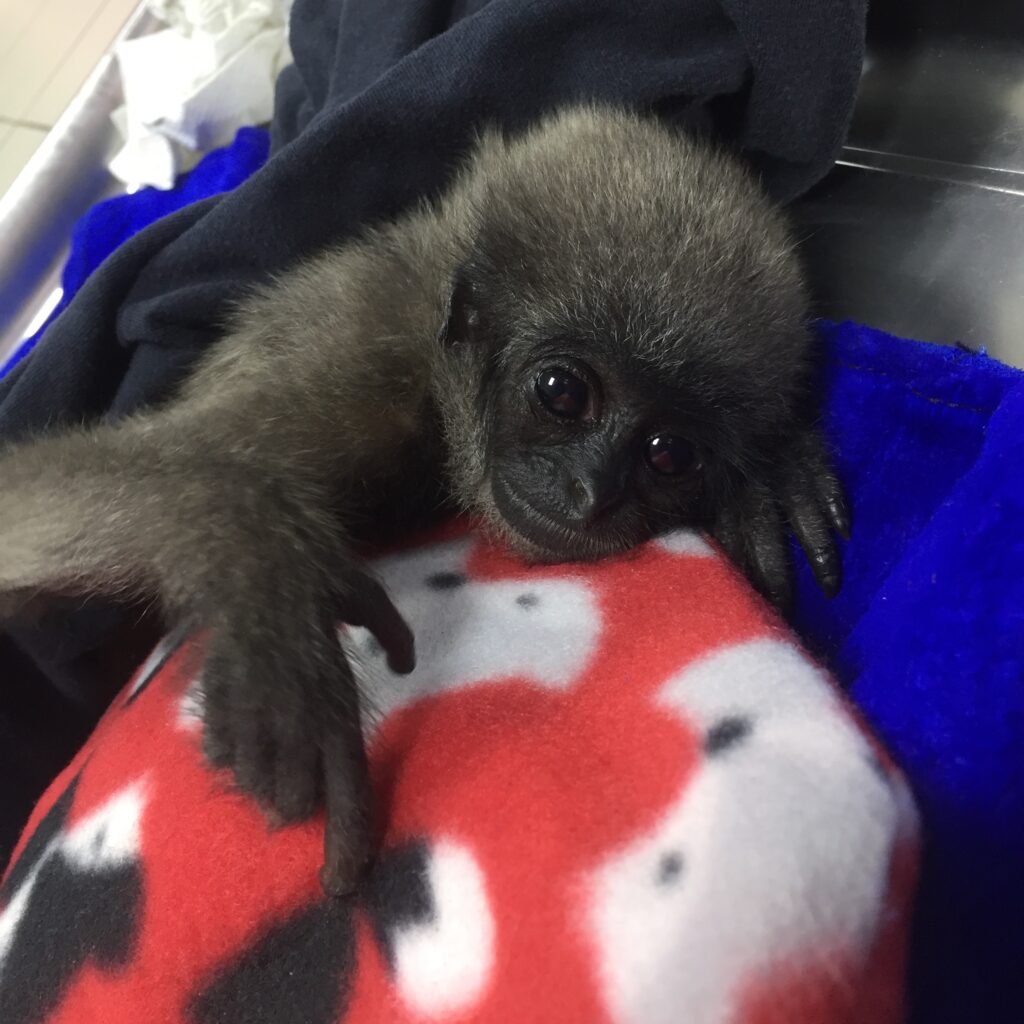
Suddenly I heard a rustling sound and snapped out of my thoughts. At first, I thought I saw another lizard in the foliage or a snake slithering through the leaves. But the sound came from above. I excitedly kept looking for moving branches. And sure enough, I spotted something in the treetops. Hastily I took out my binoculars. There I saw a bright orange head emerging from between the leaves – Red Leaf Monkeys. Chestnut langurs. Eerily cute monkeys, but unfortunately not what I’m looking for right now. Disappointed, I let myself sank back down to the ground.
An hour later, Paloma calls: “We have to make a decision now. It will be dark soon. I don’t think the parents will return today.” I nodded mutely. “Meet me in the lab in ten minutes – get ready.” And then everything happened very quickly. Wearing breathing masks and gloves, we approached the little baby monkey shortly afterwards. As cute and harmless as the little one may look, we must not forget that apes can be carriers of dangerous diseases. After all, they are uncannily similar to us in their genome. But our diseases are probably even more dangerous to the little one. Everyone who comes into contact with the baby ape must be adequately vaccinated, clinically healthy and protected, because an infection could mean death for the weakened baby.
Frightened, the baby grabbed my hands with his small, slender fingers while I carefully lifted him up. Cautiously I put a towel around him. His calls could only be heard barely. He is weakened from the long, lonely day and we have to be careful that he doesn’t get hypothermic. Back in the lab, we vets examined the baby: it is a male about two months old, it seems healthy, hungry and a bit dehydrated. The following day we will do an x-ray and a blood test at the clinic to really make sure the little one is doing well. But for now, the most important thing is to keep him warm and hydrated. I spent all night with the little gibbon, he needs closeness and attention, wants to drink every few minutes, and keeps falling asleep from exhaustion. As soon as he is warm and soft, he looks at me with his big black beady eyes – almost as if he is grateful. His little hands grab my finger when he falls asleep. Over time, I started understanding exactly when he’s thirsty, when he needs to go to the bathroom, or when he’s seeking my closeness. He is still a bit clumsy with his much too-long limbs. He can’t really climb yet, but he tries anyway and looks incredibly cute when he yawns or sucks on his finger. Paloma and I agreed: If the little one can survive the next 24 hours, he will have a chance.
An hour later, Paloma calls: “We have to make a decision now. It will be dark soon. I don’t think the parents will return today.” I nodded mutely. “Meet me in the lab in ten minutes – get ready.” And then everything happened very quickly. Wearing breathing masks and gloves, we approached the little baby monkey shortly afterwards. As cute and harmless as the little one may look, we must not forget that apes can be carriers of dangerous diseases. After all, they are uncannily similar to us in their genome. But our diseases are probably even more dangerous to the little one. Everyone who comes into contact with the baby ape must be adequately vaccinated, clinically healthy and protected, because an infection could mean death for the weakened baby.
Frightened, the baby grabbed my hands with his small, slender fingers while I carefully lifted him up. Cautiously I put a towel around him. His calls could only be heard barely. He is weakened from the long, lonely day and we have to be careful that he doesn’t get hypothermic. Back in the lab, we vets examined the baby: it is a male about two months old, it seems healthy, hungry and a bit dehydrated. The following day we will do an x-ray and a blood test at the clinic to really make sure the little one is doing well. But for now, the most important thing is to keep him warm and hydrated. I spent all night with the little gibbon, he needs closeness and attention, wants to drink every few minutes, and keeps falling asleep from exhaustion. As soon as he is warm and soft, he looks at me with his big black beady eyes – almost as if he is grateful. His little hands grab my finger when he falls asleep. Over time, I started understanding exactly when he’s thirsty, when he needs to go to the bathroom, or when he’s seeking my closeness. He is still a bit clumsy with his much too-long limbs. He can’t really climb yet, but he tries anyway and looks incredibly cute when he yawns or sucks on his finger. Paloma and I agreed: If the little one can survive the next 24 hours, he will have a chance.
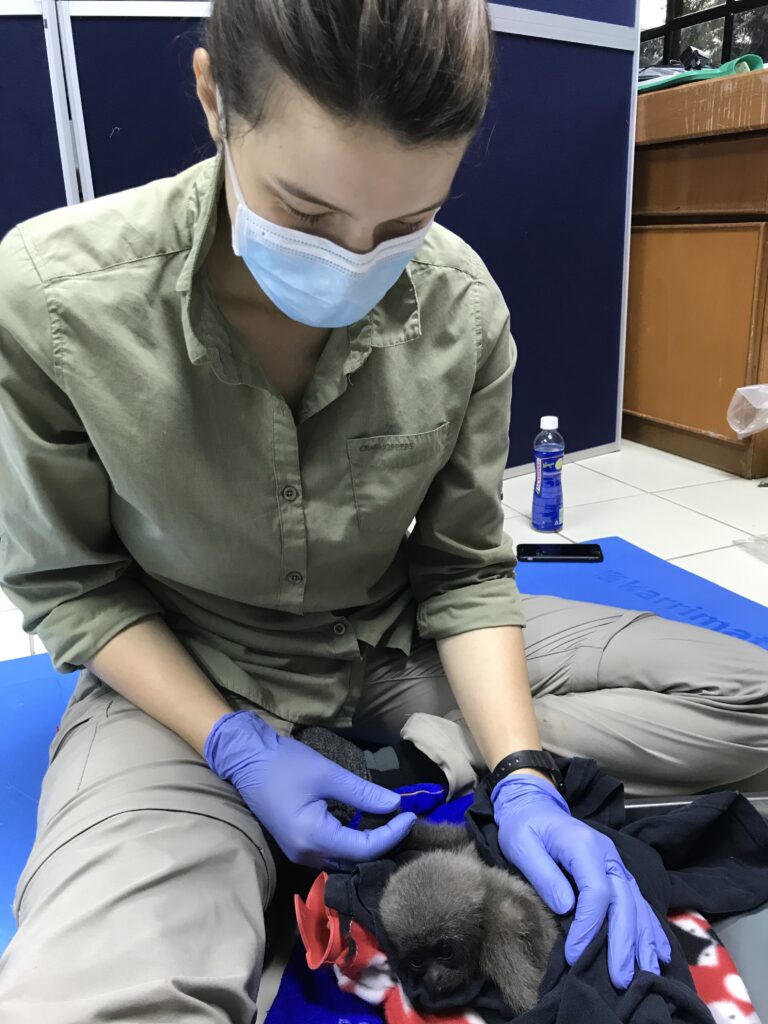
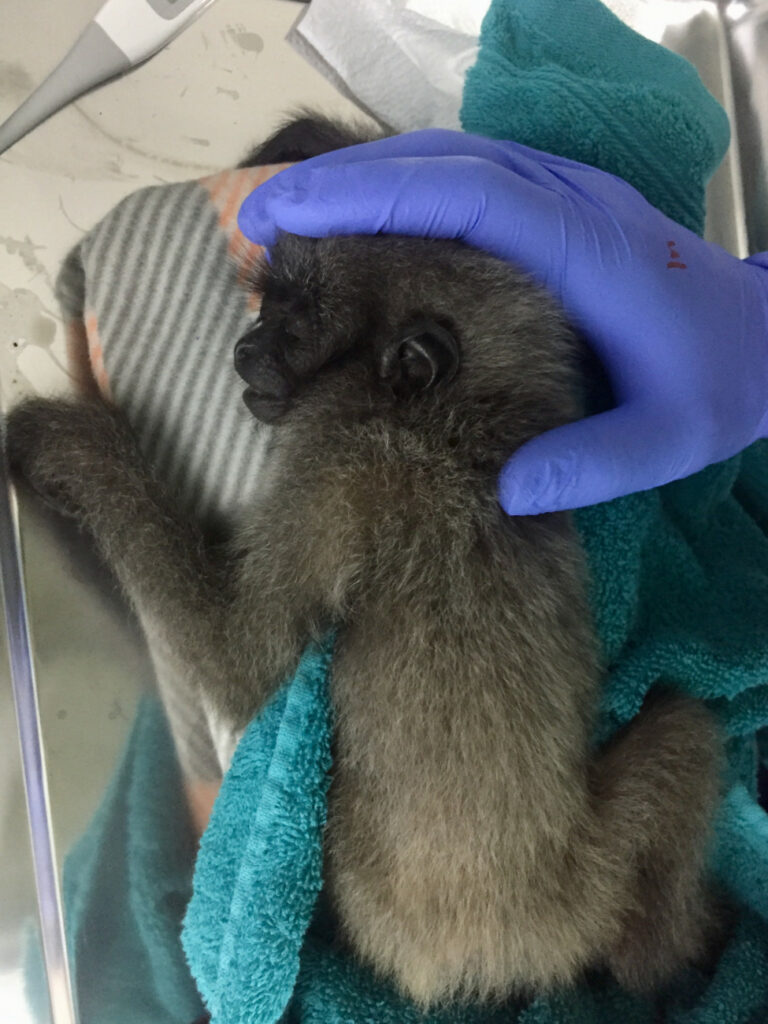
And this is exactly the chance we would like to give him with Nepada Wildlife e.V.. We have decided to work together with the national park and the Gibbon Conservation Society to establish a gibbon breeding station on Borneo. At this station, injured or orphaned animals will be taken in and cared for with the goal of reintroducing them into the national park. The conflict between humans, animals and civilization is growing here on Borneo as well: The wild animals are losing their habitat, are being forced back into ever smaller forest areas, and are threatened, injured, or disturbed by humans, construction work, highways or palm oil plantations. Together with the national park staff, we want to set up a rearing and reintroduction station that gives value to wildlife, educates locals about these problems, and seeks solutions. For this, I will spend the next four weeks preparing the premises, buying equipment and training the staff. Luckily, I’m getting support for this from gibbon expert Mariani Ramli. She is the director of the Gibbon Rehabilitation Project in Malaysia. So I will be with the little gibbon day and night, but I also have to be careful that he doesn’t imprint on me too much, after all, we want to bring him back to his family. We know that his parents are still close by and we will do everything we can to ensure that the little one can return to them healthy and strengthened.
And for this we need your help. We are setting up this project from scratch and need countless utensils that are hardly available here in the jungle and the surrounding area. Jannes will fly from Germany to Borneo at the end of the month to bring this equipment and we are dependent on any financial help or helpful donations in kind.
And for this we need your help. We are setting up this project from scratch and need countless utensils that are hardly available here in the jungle and the surrounding area. Jannes will fly from Germany to Borneo at the end of the month to bring this equipment and we are dependent on any financial help or helpful donations in kind.
Subject and purpose of donation: »Borneo Gibbons«
Account holder: Nepada Wildlife e.V.
IBAN: DE28 2005 0550 1206 1504 90 BIC: HASPDEHHXXX Hamburger Sparkasse
Subject: Borneo Gibbons
IBAN: DE28 2005 0550 1206 1504 90 BIC: HASPDEHHXXX Hamburger Sparkasse
Subject: Borneo Gibbons

HANNAH EMDE
Author, founder and 1st chairwoman of the NGO
reports on her assignments as a veterinarian in international species conservation projects
You may also like
The controversial issue of meat
Mit der Grillsaison flammt er regelmäßig wieder auf, der altbekannte Streit zwischen Fleisch-Fans
Are zoos still up-to-date?
Zoos and large show aquariums are controversial institutions for many conservationists. We ask ourse
Palm Oil – The Hidden Ingredient
About every second supermarket product contains palm oil or palm kernel oil. Nutella, the universall




